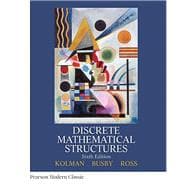This title is part of the Pearson Modern Classics series. Pearson Modern Classics are acclaimed titles at a value price. Please visit www.pearsonhighered.com/math-classics-series for a complete list of titles.
Discrete Mathematical Structures, 6th Edition, offers a clear and concise presentation of the fundamental concepts of discrete mathematics. Ideal for a one-semester introductory course, this text contains more genuine computer science applications than any other text in the field.
This book is written at an appropriate level for a wide variety of majors and non-majors, and assumes a college algebra course as a prerequisite.










